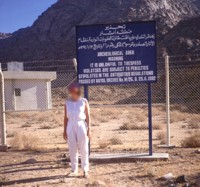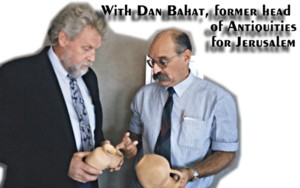Mt Sinai located in Arabia
The mountain peak scorched by Supernatural heat
Cartographers have traditionally placed Mt Sinai in what is today referred to as the Sinai Peninsular.
Every year pilgrims flock to that mountain. But having located the Red Sea crossing site in the Gulf of Aqaba, it becomes obvious that Mt. Sinai must be in Saudi Arabia.
The Bible itself bears witness to this fact, "...Mount Sinai in Arabia" (Galatians 4:25).
The mountain now believed to be the Biblical Mount Sinai is known on modern maps as Jebel el Lawz. This mountain encloses an area large enough to accommodate millions of people and their flocks and herds. The mountain's peak has been blackened. Exodus 19:18 records "And mount Sinai was altogether on a smoke, because the LORD descended upon it in fire: and the smoke thereof ascended as the smoke of a furnace."
The site shows all the evidence of being an encampment for millions of people. The are ancient tent sites, evidence of a vast water supply, and even the altar upon which the Golden Calf was erected. After Ron Wyatt drew attention to this site in 1984, the Saudi Authorities erected a wire mesh fence around the base, and declared the area as an archaeological site, off limits to unauthorized personnel. (below)
The mountain now believed to be the Biblical Mount Sinai is known on modern maps as Jebel el Lawz. This mountain encloses an area large enough to accommodate millions of people and their flocks and herds. The mountain's peak has been blackened. Exodus 19:18 records "And mount Sinai was altogether on a smoke, because the LORD descended upon it in fire: and the smoke thereof ascended as the smoke of a furnace."
The site shows all the evidence of being an encampment for millions of people. The are ancient tent sites, evidence of a vast water supply, and even the altar upon which the Golden Calf was erected. After Ron Wyatt drew attention to this site in 1984, the Saudi Authorities erected a wire mesh fence around the base, and declared the area as an archaeological site, off limits to unauthorized personnel. (below)




AT the base of Jebel el Lawz is a large altar, with Egyptian Apis bulls, or calves, inscribed onto it.
When Ron Wyatt showed this altar to an archaeologist from Rejhard University, he immediately recognised the significance of it. There is no other site like it in Saudi Arabia.
The story of the Golden Calf, in chapter 32 of Exodus, is well known, and now at last the actual altar has been found. However until the Saudi Authorities allow access to foreigners, viewing the site is extremely difficult. Yet despite this, some have successfully done so.
Water from the rock
THE evidence of another Biblical miracle is still standing today!
At the Lord's command, Moses smote what the Bible refers to as "the rock" in Horeb. Fresh water gushed forth, supplying the Hebrews, and their flocks for the two years they encamped there. Man-made channels run out from the giant rock into the plain, where the Hebrews would have been encamped, precisely what one would expect to find.(The Rock in Horeb - The close-up reveals the significant water erosion.)
THE evidence of another Biblical miracle is still standing today!
At the Lord's command, Moses smote what the Bible refers to as "the rock" in Horeb. Fresh water gushed forth, supplying the Hebrews, and their flocks for the two years they encamped there. Man-made channels run out from the giant rock into the plain, where the Hebrews would have been encamped, precisely what one would expect to find.(The Rock in Horeb - The close-up reveals the significant water erosion.)

Ron Wyatt: The Scientific approach
THE work which Ron was led to accomplish, confirming the validity of the Word of God, is touching an ever growing number of lives.
Ron Wyatt was not a professional archaeologist. He was an anaesthetist by profession. He began his personal research into ancient history, the sciences and the Bible as a young man, motivated by his own curiosity.
In 1977 Ron began field work in Turkey. In 1978 he began work in Egypt, and in 1979, Israel. At first his "team" consisted of himself and his two teenaged sons, and later, other interested individuals offered their assistance. At the time of his death in August of 1999, Ron had made over 120 trips to the Middle East. Ron funded most of his work himself. Over the years, several individuals who believed in his work also provided some financial assistance. His work was based on his profound belief in the total accuracy of the Biblical account, and on this basis, his general policy was to share these evidences with "those who ask."
Because Ron Wyatt's "Discoveries" testify to the veracity of the Biblical narrative, they are quite controversial in both the scientific and scholarly communities. As a result, Ron never looked to scientists or scholars to "confirm" them. He employed scientific testing, then presented the evidence from those tests and the testimony of experts as to the results. He then presented the body of evidence, biblical, historical, archaeological and scientific, in the belief that each individual was capable of making their own decision.

Ronald Wyatt passed away on the 4th of August, 1999. He is greatly missed by those who knew and worked with him. Many of these individuals are now carrying on the work Ron began for the LORD.